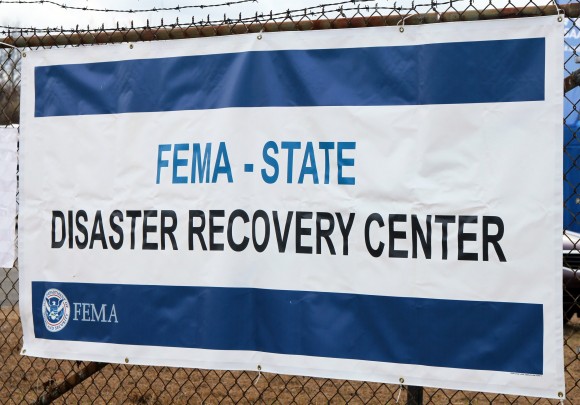President Donald Trump’s emergency management director said he’s pushing for an overhaul of disaster relief so that states, cities and homeowners bear more of the costs, and less of the risk falls on the federal government.
Brock Long, who was confirmed in June as the administrator at the Federal Emergency Management Agency, said taxpayers shouldn’t be on the hook for homes that keep flooding, and the threshold for triggering federal public assistance after a disaster might be too low. He also expressed support for an Obama administration idea to make local governments pay more when a hurricane or flood hits.
“I don’t think the taxpayer should reward risk going forward,” Long said in an interview in his office at FEMA’s headquarters in Washington. “We have to find ways to comprehensively become more resilient.”
While some of these changes will require action from Congress, the imprimatur of FEMA’s administrator could give them a boost as lawmakers face a deadline at the end of the September to rewrite the federal flood insurance program. Even without legislation, FEMA says it could shift the initial costs for disaster relief to local or state governments.
Making those changes has the support of environmentalists, who hope it will make local leaders take climate change more seriously — passing stronger building codes, moving flood-prone residents out of their homes or building stronger storm walls. But making these ideas stick won’t be easy.
State and local governments cried foul after FEMA under President Barack Obama proposed shifting onto them the initial costs of rebuilding roads, bridges or buildings after a storm. And the 5 million households with federal flood insurance rely on that program for protection against hurricanes or floods; after Congress tried to rewrite that program five years ago to cut the federal subsidy, it had to beat a retreat in the face of voter anger.
Disaster Relief
Still, the costs of natural disasters are fast running up against the limits of Congress’s ability to pay for them. The federal government spent $357 billion on disaster recovery over the past decade; the number of billion-dollar disasters in 2016 was the second-highest on record, after adjusting for inflation. The U.S. Government Accountability Office, the independent agency that advises Congress, ranks climate change as one of the greatest financial risks facing the federal government.
Against that background, environmental groups welcomed Long’s appointment, calling him a professional who understood the risks and was equipped to handle them. Long was previously the director of Alabama’s Emergency Management Agency, and before that a regional hurricane program manager for FEMA.
But even for somebody who knows the terrain, cutting federal disaster costs can be treacherous. Craig Fugate, who preceded Long as FEMA director under Obama, said that only local and state governments have the power to reduce people’s exposure to storms and similar hazards, through land-use planning, building codes and other rules. And so he pushed a plan to put those local governments on the hook for the initial costs of storm recovery, saying that would induce them to prepare better.
Disaster Deductible
In January, just before Obama left office, Fugate released a proposal to impose on states what it called a “disaster deductible”: requiring that states pay some of the cost of disaster recovery up front, before the federal government starts making what it calls “public assistance” payments to rebuild public infrastructure.
States could reduce their so-called PA deductible by taking steps to better prepare for disasters, such as imposing tougher building codes or buying insurance for their facilities. State and local governments have resisted the idea.
“The merits of the PA deductible program are good,” Long said, adding that he has concerns about the complexity of the idea, including how to fairly measure the actions states and local governments take. Still, he said, “the premise is good.”
The most urgent challenge facing FEMA is the National Flood Insurance Program, which will expire at the end of September unless Congress reauthorizes it. A series of severe storms have left the program $23 billion in debt; Congress is debating how to reduce its costs to the federal government.
Cost Burden
One option is limiting coverage for homes that flood over and over again. Long said he supports keeping those homes out of the program altogether.
“There are a handful of properties that create a large portion of that cost burden,” Long said. “We’ve got to start there, and at some point cut that off.”
The number of homes affected by such a change could be enormous. There are more than 30,000 homes that FEMA classifies as “severe repetitive loss,” according to figures obtained by the Natural Resources Defense Council. It’s not clear how many of those homeowners could obtain private insurance at a price they could afford.
Still, environmentalists support changing the policy. “Why is the federal government continuing to foot the bill to rebuild properties we know are going to flood again?” said Laura Lightbody, project director for flood-prepared communities at the Pew Charitable Trusts.
Another struggle for FEMA is whether and how to reduce spending on federal disasters.
If the federal government really wanted to cut spending, the most direct way might be to increase the damage threshold FEMA uses to decide whether to make public assistance payments. Starting in 1986, a disaster had to cost at least $1 per state resident to qualify. That figure, which has failed to keep up with inflation, is now $1.43. Long said it’s an imperfect measure of a state’s need for federal help.
“Is it a true indicator?” Long said. “Some would argue that it’s too low.”
Long broke from environmentalists and Obama-era officials on one point: He declined to say whether he believed that human activity is warming the planet, instead citing deep-water ocean currents, El Nino and other “intrinsic cycles” as reasons for changes in weather patterns. He said his job was to help state and local governments prepare for the risks they face, no matter their cause.
“The term climate change has become such a political hot button that I think it keeps us from having a real dialogue,” he said.
Related:
- Q&A with FEMA’s Fugate: Capitalism, Socialism and Disaster Mitigation
- FEMA Disaster Deductible Could Survive Trump Deregulation Drive
- IBHS CEO Julie Rochman: FEMA and Disaster Relief
- As Congress Eyes Flood Insurance Renewal, Private Markets Get Ready
- Flood Insurance Looks Like One Area of Bipartisan Agreement
- Study Shows Many Homeowners Would Do Better with Private Flood Insurance
Was this article valuable?
Here are more articles you may enjoy.



 Estimate to Rebuild Baltimore’s Key Bridge Doubles to $5 Billion
Estimate to Rebuild Baltimore’s Key Bridge Doubles to $5 Billion  Single Loose Wire Led to Blackout That Caused Dali Crash Into Baltimore Bridge
Single Loose Wire Led to Blackout That Caused Dali Crash Into Baltimore Bridge  The Hartford CEO Takes Lead in Shaping the City of Hartford’s Future
The Hartford CEO Takes Lead in Shaping the City of Hartford’s Future  Lloyd’s Probing Conduct of Ex-CEO Who Had Been Set to Join AIG
Lloyd’s Probing Conduct of Ex-CEO Who Had Been Set to Join AIG 

